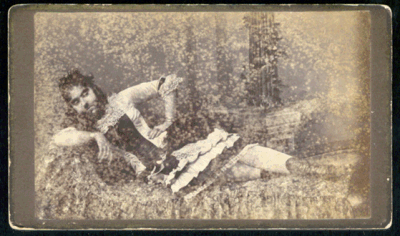Annie Jones
carte de visite, 4 x 2.5 inches, circa 1880
photographer’s logo stamped on reverse and signed in pencil "Miss Annie
Jones Age 18yrs"
photographer: Chas. Eisenmann, 229 Bowery, New York
The famous Annie Jones – the leading bearded lady of her day – here reclines
on a chaise in a rather saucy pose. This is the first instance I have
seen Annie Jones take a pose like this one. In other photographs – perhaps
later – she is generally standing in a long dress against a pillar or some
such other prop, and gazing wistfully into the distance. But here she confronts
the viewer with the demeanor of a bearded sex kitten.
As a mere child Annie started working at Barnum’s museum as "The Infant
Esau". The well-paid infant grew into the "Bearded Girl", and by the time
of this photograph was well on her way to bearded womanhood.
Miss Jones was interested in more than just life on the show platform.
She educated herself, became quite an accomplished musician, married
twice, and retired a very wealthy woman. Clearly, Annie Jones is one
of sideshow’s greatest success stories.
I have twice featured Annie in my "Prodigies" series: Ritratto di Annie
Jones is to be found
here
, and Infanta Esau may be found
here.

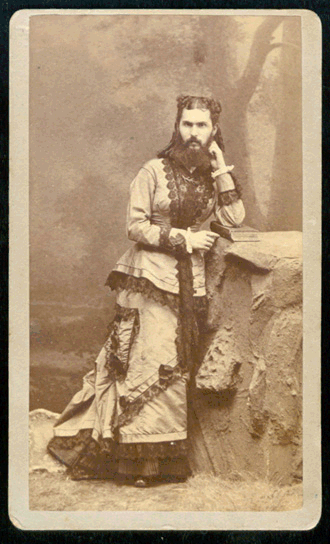
Bearded Woman
carte de visite, 4 x 2.5 inches, circa 1880
photographer’s logo stamped on reverse and signed in pencil "Mrs. A.
… Elk County PA
Age 24"
photographer: I.W. Taber & Co., Yosemite Art Gallery, 26 Montgomery
Street, San Francisco, California
I am not entirely certain of this lady’s identity. It may be Annie Jones,
who was twice married, or it may be the performer known as ‘Mrs. Meyers’.
The penciled surname on the back is difficult to decipher – it could
be "Myers" or something like "Ingram".
Another likely possibility is that this is Jane Devere, a native of Kentucky who worked for
Sells Brothers and several other shows. In 1884, Madame Devere's beard was measured at
an alleged 14 inches, which is purportedly the record length for a woman's beard.

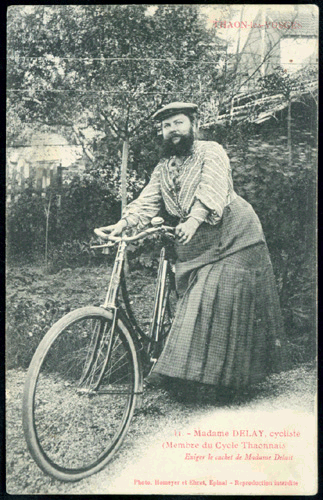
Madame Delait, cycliste
real photograph postcard, 5.5 x 3.5 inches, 1906
stamped on reverse with the lady’s own postmark: "Mme. DELAIT – 28 DEC
1906 – THAON-Vosges", and with an ink inscription (in French) possibly from
Delait herself
photographer: Homeyer et Ehret, Epinal
This is an interesting item: A photograph of the French bearded lady
Madame Delait, (curiously spelt ‘Delay’ in the title), which declares her
to be a member of a bicycling club, Cycle Thaonnais. Was this an unusual
pastime for a French lady of the time? I know not, but perhaps it was all
the more unusual for a lady bicyclist to have a beard.
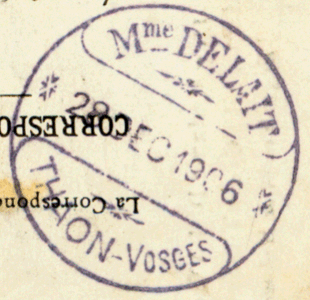
Even more interesting is the reverse of the card, which bears what
appears at first glance to be a postal cancellation stamp. Closer inspection
shows this stamp bears the lady’s own name, "Mme. DELAIT", and the date
of 28 December 1906. Apparently, Madame Delait would stamp all of her promotional postcards thusly.
As nearly as I can make out the message penned beneath, it seems to be something about having a few days free and arriving "on the
noon train on Tuesday." It ends touchingly with "I kiss you." Though I can’t be absolutely
certain, this may be an example of Madame Delait’s private correspondence, on her own personal
stationary. The good lady's date stamp apparently stood up to postal scrutiny.

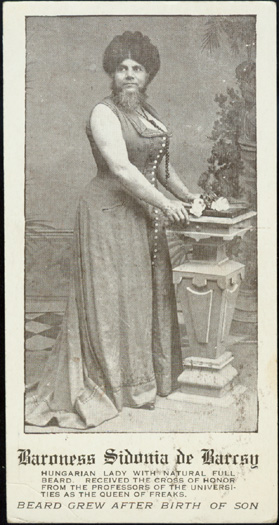
Baroness Sidonia de Barcsy
postcard, 6.25 x 3.25 inches, 1900
photographer: unknown
Baroness Sidonia de Barcsy was no run-of-the-mill bearded lady, as her credentials illustrate. The text of this postcard reads:
Baroness Sidonia de Barcsy
HUNGARIAN LADY WITH NATURAL FULL BEARD. RECEIVED THE CROSS OF HONOR FROM THE PROFESSORS OF THE UNIVERSITIES AS THE QUEEN OF FREAKS.
BEARD GREW AFTER BIRTH OF SON
The intriguing tale of Sidonia de Barcsy doesn't end there. Unlike so many circus performers
who claimed aristocratic titles for pure showmanship, de Barcsy really was a member of the
Hungarian aristocracy. In fact, apart from her royal lineage there wasn't really much unusual
about her until certain events transpired in Budapest in the mid-1880's.
The lovely and buxom Sidonia was courted by a young cavalry officer, Baron Anton de Barcsy, and
eventually the two were married. Soon afterwards Sidonia became pregnant and the couple was
overjoyed by the prospect of an heir. Little Nicu was born on 28 February 1885 – and little he
was. Although perfectly proportioned and seemingly healthy, Nicu weighed less than two pounds
at birth. Distressed by Nicu's size, Sidonia soon had problems of her own. Twelve days after
Nicu's birth, Sidonia noticed a downy fuzz growing on her chin and cheeks. The rapidity with
which this fuzz turned into a full chestnut-colored beard was in direct contrast to Nicu's
stunted development. Baron de Barcsy was forced to accept that not only was his son a dwarf,
but he was married to a bearded woman.
To further complicate matters, all was not well in Hungary on the economic and political fronts.
The country was in a state of turmoil, and the baron fell victim to the chaos. Within a
short space of time Baron de Barcsy had lost a great deal of money in stock speculation, and as
a member of the military elite he soon found himself on the wrong side of a national political
struggle. While Nicu was still quite young, the de Barcsy's were forced to flee Hungary for the
safer climes of western Europe. Now penniless refugees, the family needed to find a way to
support themselves. As aristocrats they had little experience with gainful employment, but
the baron now realized that the unique series of unfortunate familial circumstances made them
ideal candidates for work in the circus. A source of embarrassment quickly became a handsome
meal ticket.
Having quickly turned misfortune into opportunity, the de Barcsy family was a genuine
sensation with circus audiences across Europe. It could hardly have been otherwise when one
family unit contained all that a circus promoter could hope for: a bearded lady of grace and
charm, a 28-inch-tall dwarf son billed as "The Smallest Perfect Man on Earth", and a powerfully
built patriarch who often lent his 6-foot 3-inch 400lb frame to the task of strong man. For fifteen
years the family performed all over Europe, but in 1903 set sail for the greener shores of
America.
By 1903, Nicu was 18-years old and proudly wearing the Hungarian silver cross, which he claimed
as his birthright. Nicu also insisted that he be addressed as "Capitain". For the next decade, the
de Barcsy's worked with most of the best known shows, including Ringling Brothers Barnum and
Bailey, Hagenbeck and Wallace, and the Campbell Brothers Circus. Perhaps fascinated by their
royal heritage, American audiences received the de Barcsy's even more warmly than they had been
accustomed to in Europe. During the winter months, the de Barcsy's lived quietly in a
fashionable New York City apartment.
In 1912, Baron de Barcsy passed away. Nicu and Sidonia carried on gamely without him, but
Sidonia surprised everyone when after a short period of mourning she took a second husband,
Frederick Valentine Tischu. Tischu, German and Native American by heritage, was
billed as "The Long-haired Cherokee Buck Man" and performed in the circus as a trick roper.
"Buck" (a.k.a. 'C. H. Buck') had some chronic trouble handling money, and in 1914 sold off all of
Sidonia's fine furniture from the New York apartment — perhaps to pay off his gambling debts.
Now in desperate financial straits, Sidonia took out an ad in Billboard which read:
Trio seeking rewarding position — sophisticated bearded woman, of royal lineage;
midget son, who does card tricks and performs on or with small animals; and wild Indian man,
trick roper. Temporary financial embarrassment requires small advance. Serious only need
apply.
This ad was spotted by W. H. "Bill" Campbell, a nephew of the Campbell Brothers for whom the
de Barcsy's had worked in happier times. Campbell met Sidonia's terms, and the three
joined his wagon show, which wintered every year on farmland he owned outside of Drummond,
Oklahoma.
That first chilly Oklahoma winter was difficult as Madame de Barcsy was low on cash, and Buck and Nicu
had no money of their own. An auto dealer who owned a boarding house took them in on credit, with
assurances he would be repaid in full the following season. Madame de Barcsy was charmed by the small
prairie town and gratified by the trust and help she received from its inhabitants. She announced she
intended to return to Drummond to make it her permanent home.
That spring, Sidonia, Nicu and Buck played a full season on Coney Island. They returned to
Drummond with several thousand dollars, which Sidonia used to purchase a plot of land and
build a brick home on Drummond's main street. She was well accepted by the citizens of
Drummond, who were accustomed to see her around town wearing a hat covered with a large scarf
which was knotted under her chin to hide her beard, so as not to cause too much of a sensation.
Even in retirement Sidonia refused to get rid of her greying beard, telling people that
"God sent this beard to me and I won't take it off"
Sidonia, Nicu and Buck continued to play in large and small circuses for the next eight seasons.
However, Sidonia had begun to develop diabetes, and as her health waned her appearances
became less frequent. By 1923, Sidonia had largely retired. As she grew ever more ill and unable
to bring in a paycheck, Buck abandoned Sidonia for the more lucrative and still working dwarf woman
Dolletta Boykin,
the recently widowed "Smallest Mother in the World". Sidonia heard that Buck and Dolletta wintered
in Texas, but Sidonia never attempted to file for divorce (perhaps because there had never been
a legal marriage between herself and Buck).
Sidonia de Barcsy passed away in her 59th year on 19 October 1925, due to her diabetes and
complications from a cold. A funeral was held for her in Drummond, and then little Nicu
(now 40 years old) accompanied her body by train to Kansas City, Missouri – which was the
nearest town with a crematorium. Sidonia's remains were sent to New York to lay in a crypt
beside those of the baron.
Little Nicu continued to exhibit himself for several years after Sidonia's death and Buck's
departure, but he retired to the house in Drummond in 1937. Nicu claimed his reasons for
retiring were fear of kidnappers, and his conviction that the dust of the road would kill him.
Nicu gained a reputation as a local character who freeloaded meals from
neighbors and demanded that gawking tourists pay him fifteen cents to watch his trained dog
smoke a pipe. Eventually monetary problems overcame him and he was forced to seek welfare
assistance. This was especially ironic in light of statements Nicu's mother had confided to
certain Drummond residents: that Nicu, himself now a baron, should rightly share in the
sizeable estate of an uncle in Hungary, but important papers proving his birthright had been
lost in a circus fire in Illinois.
In his later years Nicu experienced ever increasing kidney problems, and after frequent
hospitalizations his friends convinced him to enter a nursing home in Enid. His health
worsened and he was confined to a wheelchair. The state demanded that Nicu's house – now
long vacant and the frequent target of vandalism – be sold in order to defray Nicu's medical
expenses. The house sold at auction for much less than Sidonia had originally paid for it half
a century earlier. Nicu never fully understood what had become of his home, and often begged
visitors to take him back there. Nicu never knew that Sidonia's house had been bulldozed.
Nicu died in an Enid hospital on 31 July 1976, at the age of 91. The patrons of a local bar he
frequented took up a collection to pay his burial expenses, and he was interred in the Del
Norte Cemetery, under a marble monument marked "Baron Capitain Nicu de Barcsy, The Smallest
Perfect Man on Earth".
|

